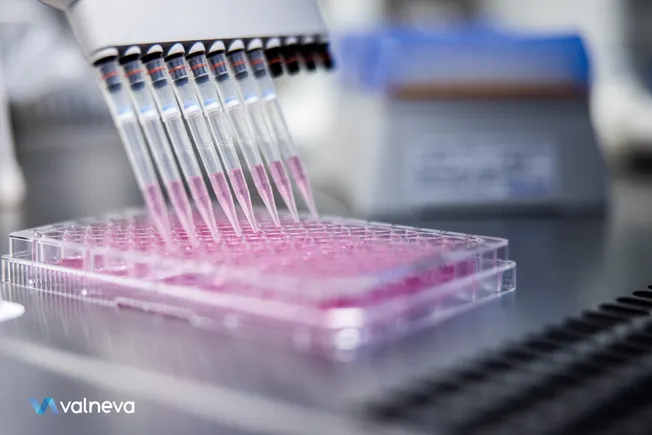Breaking down the role of the gut microbiome


When it comes to the human body, we are never truly alone. In fact, we share our bodies – specifically the surfaces of our skin, noses, mouths, vaginas for some of us and intestinal tracts – with a diverse and complex colony of microorganisms, called the microbiome. These microscopic ecosystems play host to trillions of bacteria, fungi, archaea and viruses, known collectively as microbiota, that comprise an estimated 500 to 1,000 different species.¹ ² ³ ⁴
Advances in biotechnology have supported a surge in research, including the National Institutes of Health’s Human Microbiome Project⁵, to understand the composition and function of the microbiome. Interest in the role of the microbiome in promoting human health and mitigating disease is at an all-time high.⁶
The gut microbiome plays a central role in keeping us healthy. This colony of microbiota lives within the large intestine, just beyond the anus and rectum⁷, and has been shown to enhance immunity, prevent colonization by harmful pathogens and form a protective barrier between the cells of the intestine walls and its contents.⁸ ⁹ ¹⁰ The gut microbiome, now considered a distinct and essential organ within the body,¹¹ is also connected to a wide range of diseases, such as obesity, inflammatory bowel disease, liver disease and infections to name a few.⁶
There is a relationship between the microbiota living within our gut and the human cells that make up the walls of the intestines. Everyone has their own diverse mix of microbiota,¹ ¹² but the most prevalent phyla of organisms are Bacteroidetes and Firmicutes.¹³ ¹⁴ ¹⁵ While both of these phyla include beneficial and harmful species, the helpful ones play an important role in the microbiome’s protective function. Bacteroidetes, are gram-negative bacteria, some of which modulate the immune system and may have the ability to stop harmful pathogens.¹³ ¹⁶ ¹⁷ ¹⁸ Gram-positive Firmicutes are composed of helpful and harmful bacteria.² ¹⁷ Firmicutes are the most abundant and diverse bacterial gut species,² with functions that include anti-inflammatory effects¹⁹ ²⁰ ²¹ and fortification of the gut barrier (along with other bacteria).²² ²³ ²⁴
When the volume and diversity of microbiota are disrupted, an imbalance, called dysbiosis, occurs. Dysbiosis can be caused by diet, hygiene and other drug therapies, including antibiotics used to treat infections.⁸ ²⁵ ²⁶ Dysbiosis has been associated with a range of GI and non-GI diseases, including neurologic, metabolic, liver, inflammatory diseases and infections such as C. difficile.⁸ ²⁶ ²⁷
Classified as an urgent public health threat by the Centers for Disease Control and Prevention (CDC), C. difficile infection is a serious disease that may result in life-threatening medical emergencies, causing about half a million illnesses and nearly 30,000 deaths in the U.S. each year.²⁷ Because C. difficile infections are extremely contagious they can spread easily in communal settings and are the most common healthcare-associated infections in U.S. hospitals.²² ²⁸ ²⁹ The burden of these infections on the U.S. healthcare system is significant. In fact, two studies show 57% of Medicare patients with C. difficile infection were hospitalized at least twice a year, with each hospital stay lasting an average of 18 days. Total medical costs for Medicare patients with recurrent C. difficile infection ranged from $131,000 to $207,000.³⁰ ³¹
C. difficile infection is often the start of a vicious cycle of recurrence, and while antibiotics are the standard treatment for initial C. difficile infection, they fail to address the underlying dysbiosis associated with recurrence, increasing the likelihood of subsequent recurrences.³² ³³ ³⁴ In fact, studies have shown C. difficile infection recurs in up to 35% of cases within eight weeks of initial diagnosis. Moreover, up to 65% of those patients go on to experience additional recurrences.²⁰ ³⁵
To reduce the likelihood of recurrence, it is necessary to address dysbiosis. That means repopulating the gut microbiome with diverse and plentiful healthy microbiota.⁸ ²¹ ²² While probiotics are helpful for maintaining a healthy gut environment, they do not restore the microbiome by addressing dysbiosis.³⁶ ³⁷ ³⁸ The good news is that as scientists advance their understanding of the gut microbiome, they are shedding new light on ways to unlock its power to address serious diseases, including the vicious cycle of C. difficile infection recurrence.
To learn more about the gut microbiome, visit www.PowerofMicrobiome.com.
Resources
¹ Gilbert JA, Blaser MJ, Caporaso JG, et al. Current Understanding of the Human Microbiome. Nat Med. 2018;24(4):392-400.
² Antharam VC, Li EC, Ishmael A, et al. Intestinal dysbiosis and depletion of butyrogenic bacteria in Clostridium difficile infection and nosocomial diarrhea. J Clin Microbiol. 2013;51(9):2884-2892.
³ Thursby E, Juge N. Introduction to the human gut microbiota. Biochem J. 2017;474(11):1823-1836.
⁴ Marchesi JR, Adams DH, Fava F, et al. The gut microbiota and host health: a new clinical frontier. Gut. 2016;65(2):330-339.
⁵ Integrative HMP (iHMP) Research Network Consortium. The Integrative Human Microbiome Project: dynamic analysis of microbiome-host omics profiles during periods of human health and disease. Cell Host Microbe 2014;16, 276–289.
⁶ Allaband C, McDonald D, Vázquez-Baeza Y, Minich JJ, Tripathi A, Brenner DA, Loomba R, Smarr L, Sandborn WJ, Schnabl B, Dorrestein P, Zarrinpar A, Knight R. Microbiome 101: Studying, Analyzing, and Interpreting Gut Microbiome Data for Clinicians. Clin Gastroenterol Hepatol. 2019 Jan;17(2):218-230. Epub 2018 Sep 18.
⁷ Donaldson GP, Lee SM, Mazmanian SK. Gut biogeography of the bacterial microbiota. Nat Rev Microbiol. 2016;14(1):20-32.
⁸ Bien J, Palagani V, Bozko P. The intestinal microbiota dysbiosis and Clostridium difficile infection: is there a relationship with inflammatory bowel disease? Therap Adv Gastroenterol. 2013;6(1):53-68.
⁹ Ley R, Hamady M, Lozupone C, et al. Evolution of mammals and their gut microbes. Science. 2008;320(5883):1647-1651.
¹⁰ Mazmanian S, Liu C, Tzianabos A, Kasper D. An immunomodulatory molecule of symbiotic bacteria directs maturation of the host immune system. Cell. 2005;122(1):107-118.
¹¹ Baquero F, Nombela C. The microbiome as a human organ. Clin Microbiol Infect. 2012 Jul;18 Suppl 4:2-4.
¹² Flores GE et al. Temporal variability is a personalized feature of the human microbiome. Genome Biol. 2014;15:531.
¹³ Wexler AG, Goodman AL. An insider’s perspective: Bacteroides as a window into the microbiome. Nat Microbiol. 2017;2(1):17115.
¹⁴ Rinninella E, Raoul P, Cintoni M, et al. What is the Healthy Gut Microbiota Composition? A Changing Ecosystem across Age, Environment, Diet, and Diseases. Microorganisms. 2019;(7)1:14.
¹⁵ Nishijima S, Suda W, Oshima K, et al. The gut microbiome of healthy Japanese and its microbial and functional uniqueness. DNA Res. 2016;23(2)(Suppl Table S6).
https://academic.oup.com/dnaresearch/article/23/2/125/1745357#supplementary-data. Accessed September 5, 2021.
¹⁶ Gill SR, Pop M, Deboy RT, et al. Metagenomic analysis of the human distal gut microbiome. Science. 2006;312(5778):1355-1359.
¹⁷ Kurokawa K, Itoh T, Kuwahara T, et al. Comparative metagenomics revealed commonly enriched gene sets in human gut microbiomes. DNA Res. 2007;14(4):169-181.
¹⁸ Faith JJ, Guruge JL, Charbonneau M, et al. The long-term stability of the human gut microbiota. Science. 2013;341(6141):1237439.
¹⁹ Sokol H, Pigneur B, Watterlot L, et al. Faecalibacterium prausnitzii is an anti-inflammatory commensal bacterium identified by gut microbiota analysis of Crohn disease patients. Proc Natl Acad Sci U S A. 2008;105(43):16731-16736.
²⁰ Willing BP, Dicksved J, Halfvarson J, et al. A pyrosequencing study in twins shows that gastrointestinal microbial profiles vary with inflammatory bowel disease phenotypes. Gastroenterology. 2010;139(6):1844-1854.e1.
²¹ Machiels K, Joossens M, Sabino J, et al. A decrease of the butyrate-producing species Roseburia hominis and Faecalibacterium prausnitzii defines dysbiosis in patients with ulcerative colitis. Gut. 2014;63(8):1275-1283.
²² Paust S, Lu L, Mccarty N, Cantor H. Engagement of B7 on effector T cells by regulatory T cells prevents autoimmune disease. Proc Natl Acad Sci U S A. 2004;101(28):10398-10403.
²³ El Aidy S, van Baarlen P, Derrien M, et al. Temporal and spatial interplay of microbiota and intestinal mucosa drive establishment of immune homeostasis in conventionalized mice. Mucosal Immunol. 2012;5(5):567-579.
²⁴ Lawley TD, Walker AW. Intestinal colonization resistance. Immunology. 2013;138(1):1-11.
²⁵ Weiss GA, Hennet T. Mechanisms and consequences of intestinal dysbiosis. Cell Mol Life Sci. 2017;74(16):2959-2977.
²⁶ Riaz Rajoka MS, Shi J, Mehwish HM, et al. Interaction between diet composition and gut microbiota and its impact on gastrointestinal tract health. Food Science and Human Wellness. 2017;6(3):121-130.
²⁷ Lessa FC, et al. Burden of Clostridium difficile infection in the United States. N Engl J Med. 2015;372(9):825-834.
²⁸ Centers for Disease Control and Prevention website. 2021 Antibiotic Resistance Threats Report: Clostridioides Difficile. https://www.cdc.gov/drugresistance/pdf/threats-report/clostridioides-difficile-508.pdf. Accessed August 25, 2021.
²⁹ Guh AY, Mu Y, Winston LG, et al. Trends in U.S. burden of Clostridioides difficile infection and outcomes. N Engl J Med. 2021;382(14):1320-1330.
³⁰ Nelson WW, Scott TA, Boules M, et al. Health care utilization and costs of recurrent Clostridioides difficile infection in the elderly: a real-world claim analysis. J Manag Care Pharm. 2021;27(7):828-838.
³¹ Feuerstadt P, Boules M, Stong L, et al. Clinical complications in patients with primary and recurrent Clostridioides difficile infection: a real-world data analysis. SAGE Open Medicine. January 2021.
³² Aukes L, Fireman B, Lewis E, Timbol J, Hansen J, Yu H, Cai B, Gonzalez E, Lawrence J, Klein NP. A Risk Score to Predict Clostridioides difficile Infection. Open Forum Infect Dis. 2021 Feb 4;8(3):ofab052. doi: 10.1093/ofid/ofab052. PMID: 33738316; PMCID: PMC7953654.
³³ Depestel, D. D., & Aronoff, D. M. (2013). Epidemiology of Clostridium difficile infection. Journal of pharmacy practice, 26(5), 464–475. https://doi.org/10.1177/0897190013499521
³⁴ Knight CL, Surawicz CM. Clostridium difficile Infection. Med Clin North Am. 2013 Jul;97(4):523-36, ix. doi: 10.1016/j.mcna.2013.02.003. Epub 2013 Apr 24. PMID: 23809712.
³⁵ Cornely OA, Miller MA, Louie TJ, Crook DW, Gorbach SL. Treatment of first recurrence of Clostridium difficile infection: fidaxomicin versus vancomycin. Clin Infect Dis. 2012;55 Suppl 2(Suppl 2):S154-S161.
³⁶ Cordaillat-Simmons, M., Rouanet, A. & Pot, B. Live biotherapeutic products: the importance of a defined regulatory framework. Exp Mol Med 52, 1397–1406 (2020). https://doi.org/10.1038/s12276-020-0437-6
³⁷ Kelly, Colleen R. MD, AGAF, FACG1; Fischer, Monika MD, MSc, AGAF, FACG2; Allegretti, Jessica R. MD, MPH, FACG3; LaPlante, Kerry PharmD, FCCP, FIDSA4; Stewart, David B. MD, FACS, FASCRS5; Limketkai, Berkeley N. MD, PhD, FACG (GRADE Methodologist)6; Stollman, Neil H. MD, FACG7 ACG Clinical Guidelines: Prevention, Diagnosis, and Treatment of Clostridioides difficile Infections, The American Journal of Gastroenterology: June 2021 – Volume 116 – Issue 6 – p 1124-1147 doi: 10.14309/ajg.0000000000001278
³⁸ Suez J, Zmora N, Zilberman-Schapira G, Mor U, Dori-Bachash M, Bashiardes S, Zur M, Regev-Lehavi D, Ben-Zeev Brik R, Federici S, Horn M, Cohen Y, Moor AE, Zeevi D, Korem T, Kotler E, Harmelin A, Itzkovitz S, Maharshak N, Shibolet O, Pevsner-Fischer M, Shapiro H, Sharon I, Halpern Z, Segal E, Elinav E. Post-Antibiotic Gut Mucosal Microbiome Reconstitution Is Impaired by Probiotics and Improved by Autologous FMT. Cell. 2018 Sep 6;174(6):1406-1423.e16. doi: 10.1016/j.cell.2018.08.047. PMID: 30193113
This post has been syndicated from a third-party source. View the original article here.



